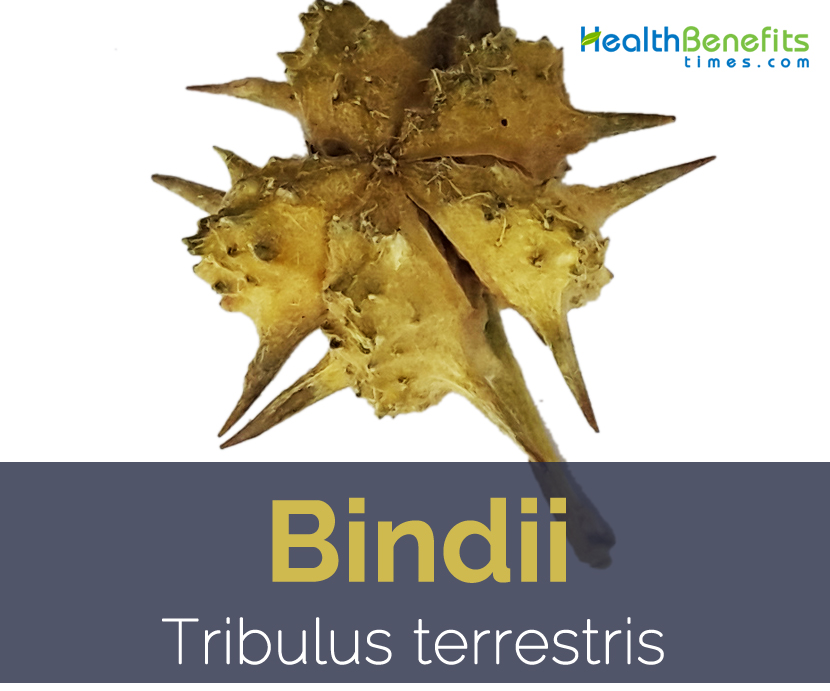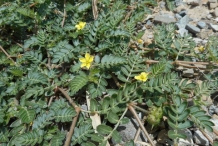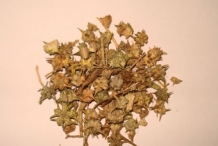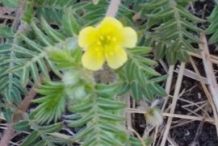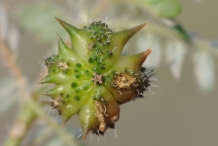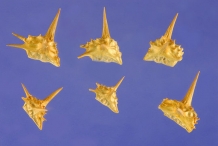Growing Environment
Puncture Vine (Bindii) is an herbaceous perennial plant which normally grows in warm climates, and can thrive in deserts and other poor growing conditions. It prefers light textured soils but will grow over a wide range of soil types.
Plant
A network of fine rootlets arises from the taproot of Puncture Vine plant to take advantage of soil moisture, by which the plant can survive in very arid conditions. Stems release from the crown to a diameter of about 10 cm to over 1 m, often branching. They are usually prostrate, forming flat patches, though they may grow more upwards in shade or among taller plants. Stems branch from the crown and are densely hairy. Leaves are opposite and pinnately compound. Densely hairy leaflets are opposite and up to 1⁄8 inch (0.0032 m) long. The flowers are 4–10 mm wide, with 5 lemon-yellow petals, 5 sepals, and 10 stamens. In Southern California, it blooms from April through October, where it is highly invasive in waste places and disturbed sites.
Fruit
A week after each flower blooms, it is followed by a fruit that simply falls apart into 5 nutlets or burs. The nutlets are hard and bear 2-4 sharp spines, 10 mm long and 4–6 mm broad point-to-point. These nutlets amazingly resemble goats’ or bulls’ heads; the “horns” are sharp enough to puncture bicycle tires and lawn mower tires and to cause painful injury to bare feet. Within each nutlet, seeds are stacked on top of each other, separated by a hard membrane. As an adaptation to dry climates, the largest seed germinates first, while the others may wait until more moisture is available before germinating.
Health benefits of Puncture Vine
Puncture Vine can also be understood with all the name puncture vine, it continues to be as a general tonic below the use. It’s used for the higher care of urinary function and effective kidneys as well as in reducing renal suffering. Another astonishing health benefits comprises raising the low libido, improving energy and stamina, treating the kidney renal rocks and issues. Let’s see the benefits in an apparent way.
1. Treats low libido
People with low libido and who are having troublesome sex life can take the advantage of Puncture Vine. It treats the infertility problems in a natural way. Research showed that Bindii helps for the restoring of the low testosterone levels.
The working action of Puncture Vine involves with stimulating the body’s natural hormone, through which it helps for the production and maintenance of the testosterone levels.
2. Heart benefit
Puncture Vine is beneficial in reducing the cholesterol levels, which is actually essential to reduce the risk of heart stroke. It also functions great in reducing the blood sugar levels and blood pressure levels. Along with it. Puncture Vine also treats the heart complications like angina. Bindii is having rich properties of antibiotic and anti-tumor, which helps to combat with the liver cancer.
3. Anti-aging
Puncture Vine which boost up the libido through storing high testosterone levels in the body also takes care about the problems that encounter during the ageing process. Regular intake of Puncture Vine extract will make the age not to show its effects on the appearance. The same property helps to treat many physiological problems that are related with age like wrinkles and muscular degeneration.
4. Erectile dysfunction
Puncture Vine is advantageous in erectile dysfunction as it encourages the penile tissue by which it enhances the penile erection.
5. Helpful in Polycystic ovarian disease
It is a cause of the female infertility. Usage of Puncture Vine is quite beneficial for such patients.
6. Reduces urinary problems
Urinary tract problems mostly take place due to the buildup of the stones in the tract. Puncture Vine extract consumption helps to eliminate the stones in the tract, through which it makes the urine flow smooth. It also stops the urinary tract bleeding and treats renal ailments incontinence and cystitis.
7. Fights water retention
As a natural diuretic, Puncture Vine helps in removing the additional amount of water in the body and it reduces the size of cyst. Puncture Vine is used in the treatment of diabetes. People with Polycystic Ovarian Disease may also develop diabetics due to glucose intolerance.
8. Fights glucose intolerance
Puncture Vine has the ability to increase capacity while work outs, similarly it helps women to strengthen their muscles, who can involve more into work outs.
Other Benefits
- Puncture Vine improves muscle growth and body strength.
- Helps in alleviating some symptoms associated with male menopause.
- Reduction in cholesterol.
- Inhibition of stress-induced clumping of blood platelets.
- Increases in strength of contraction of the heart muscle.
- Reductions in sodium and fluid retention.
- Anti-urolithiatic (urinary/kidney stone preventing) and litholytic (dissolving) activities.
- Improvement of the profile of red and white blood cells and stimulation of the humoral immune system.
- Used in to cure headache, eye problem as hives, conjunctivitis, weak eyesight and anxiety.
- It is used to cure high blood pressure and flank pain.
- For athletic performance, muscle mass enhancement, and as a testosterone booster.
- It suitable for premenstrual syndrome and menopausal syndrome.
Ayurvedic Health benefits of Puncture Vine
- Sexual weakness: Boil Gokharu powder, ashwagandha powder in one cup milk. Drink twice a day for ten days. Gokharu contains saponins which stimulates secretion of Testosterone and promotes spermatogenesis.
- Kidney stone: Prepare decoction of Gokharu fruit or panchang (all parts of Gokharu herb) in water and drink twice a day.
- Increased Serum Creatinine: Take gokharu, Sonth(Dry ginger), methi (Fenugreek seeds) and ashwagandha in equal quantities. Grind to make powder. Take this powder twice a day. It decreases Uric acid and gives relief in swelling.
- Coughing: Take Gokharu, tulsi leaves and dry ginger powder. Grind and take in small amount.
- Frequent urination, urine infection: Mix black sesame powder and Gokharu powder in equal quantity. Take twice a day.
- Urine blockage, painful urination: Take Gokharu fruits (1 tsp), coriander seeds (½ tbsp) in water (450 ml). Cook till volume reduces to half. Drink prepared infusion (2 tbsp.) twice a day for few days.
- Blood in urine: Take whole plant of Gokharu. Wash to clean dirt and soil. Grind the herb to extract juice (¼ cup). Mix this juice in a cup of buttermilk and drink for ten days.
- Jaundice: Take whole Gokharu plant, clean it and dry in shade. Grind to make powder. Mix this powder with cinnamon (1 tsp), cardamoms (6), and misri (1/4 cup). Take this powder (1/2 tsp ) three times a day with water.
- Weakness, muscle building: Mix Gokharu, mulehti, bhringraj and amla. Grind to make powder and take twice a day.
- Uterus infection and inflammation: Prepare decoction of Gokharu fruit (10 gm.) and ajwain (2 gm.) in water and drink for few days.
- Leucorrhoea: Take fresh Gokharu and bhumi amla. Grind and make paste. Take this paste (1 tbsp) with yoghurt twice a day for 10 days.
- Rheumatic joints: Drink a decoction of Land-calotrops and dry ginger every morning to reduce pain and improve digestion.
- Excessive bleeding: Boil gokhru powder in milk and drink twice a day to arrest bleeding and build lost strength.
- Alopecia: Paste Land-calotrops and sesame flowers in equal quantities with honey and apply on the bald areas to stimulate regrowth of hair and nourish the scalp.
- Diabetes: Gokhru is combined with Guggulu and other drugs and rolled into pills. This is available in the market as Gokshuradi Guggulu. This mitigates pain, swelling, and such other conditions.
Other traditional benefits of Puncture Vine
- It is believed to be useful in kidney, bladder, urinary tract and uro-genital related conditions, where it is said to act as a diuretic.
- It is used in Ayurvedic medicine for the better maintenance of efficient kidneys and urinary function and in reducing renal discomfort.
- It helps to increase the low libido, enhancing stamina and energy, treating the kidney problems and renal stones.
- For development of the male reproductive system, Puncture Vine is used in the traditional Chinese medication.
- It is widely used to enhance sexual desire in both men and women, and to treat erectile dysfunction in men.
- Body builders sometimes use it after a cycle of anabolic steroids to restore testosterone levels in the body.
- It is believed to be helpful in treating some cardiovascular conditions including angina, high blood pressure, high cholesterol, anemia and poor circulation.
- It is used in Chinese medicine as a liver tonic, and for food poisoning and overeating.
- It works against the itchy skin and purifies the blood.
- Gokharu is useful in the treatment of reproductive and nervous system.
- It increases appetite and normalize digestion.
- It is famous for the treatment of rheumatism.
- Gokhru leaves are used for the treatment of diabetes.
- It also cures heart disease and clears breathing difficulties.
- It cures gout and hematuria.
- It is also used for the treatment of gall bladder stones.
- It is helpful in Bright’s disease.
- It also cures dropsy.
Precautions
- Puncture Vine is not recommended for use in pregnant or nursing women.
- It may cause stomach upset, but this can usually be controlled by taking the herb with food.
- It may affect blood sugar levels.
Puncture Vine Facts
Puncture Vine scientifically known as Tribulus Terrestris is an annual plant in the Caltrop Family (Zygophyllaceae) widely distributed around the world, that is adapted to grow in dry climate locations in which few other plants can survive. It is an invasive species in North America. Like many weedy species, this plant has many common names, including bullhead, burra gokharu, caltrop, cat’s head, devil’s eyelashes, devil’s thorn, devil’s weed, goat head, Puncture Vine, tackweed. It is a tap rooted herbaceous perennial plant that grows as a summer annual in colder climates. It is native to warm temperate and tropical regions of the Old World in southern Europe, southern Asia, throughout Africa, and Australia. It can thrive even in desert climates and poor soil.
| Puncture Vine (Bindii) Quick Facts | |
|---|---|
| Name: | Puncture Vine (Bindii) |
| Scientific Name: | Tribulus terrestris |
| Origin | Old World in southern Europe, southern Asia, throughout Africa, and Australia. |
| Colors | Initially green, but later turns brown. |
| Shapes | Woody burr, approximately 1 cm in diameter, which splits into 4 or 5 wedge-shaped segments |
| Health benefits | Fights glucose intolerance, Fights water retention, Reduces urinary problems, Helpful in Polycystic ovarian disease, Erectile dysfunction, Anti-aging, Heart benefit, Treats low libido |
| Name | Puncture Vine |
|---|---|
| Scientific Name | Tribulus terrestris |
| Native | Old World in southern Europe, southern Asia, throughout Africa, and Australia |
| Common Names | Bindii, bullhead, burra gokharu, caltrop, cat’s head, devil’s eyelashes, devil’s thorn, devil’s weed, goathead, Puncture Vine, Puncturevine, tackweed |
| Name in Other Languages | English: Bullhead, Calthrop, caltrop, Caltrops, Cat´s-Head, Devil’s eyelashes, devil’s thorn, Devil´s-Thorn, Devil´s-Weed, goathead, Goats Head, Land calotrops, Land caltrops, Mexican sandbur, Puncture Plant, puncture vine, puncture-vine, Texas sandbur, Tribulus, common dubbletjie, bendy-eye Sanskrit: Gokshura, Trikata, Svadamshtra, Traikantaka Arabic: Chokaziz, kutrah, jtb (jatb) (جطب (جَطب), khurshum alnnaeajih (خرشوم النعجه)، khishum alnnaejih (khayshwm alnnaejat) (خيشوم النعجه (خَيْشوم النعجة), darisuh (دريسه), duqn alshshaykh (daqn alshykh) (دقن الشيخ (دَقن الشيخ)، duqn alshshaykh (dhaqn alshykh) (دقن الشيخ (ذَقن الشيخ), shqshq (shiqshiq) (شقشق (شِقشِق)، daris (dirys) (دريس (دِريس), dacn-ash-sheikh; dreiss; gutiba; kharshoom-an-naga; kotaba; shiqshi Chinese: 蒺藜, Ji Li, French: Croix de Malte, Tribule terrestre German: Erd-Burzeldorn, Gewöhnlicher Burzeldorn Hindi: Chhotagokhru, chhota gokhar (छोटा गोखर्) Italian: Caciarello, tribolo Japanese: Hamabishi, ハマビシ Kazakh: Temirtikan Korean: Namgasae Malayalam: Mulluringi, Nerunji, Njerinjil Portuguese: Abrolhos Romanian: Colţii babei Russian: Jakorcy steljuščiesja, yakortsy stelyushchiyesya (якорцы стелющиеся) Spanish: Abrojo terrestre; cachito; diablito; toboso; torito, abrojos, espigon Swedish: Tiggarnöt Tamil: Nerinji, Nerinji Sanna neggilu -Ka Uzbek: Temirtikan Assamese : Gokshura, Gukhurkata Bengali : Gokshura, Gokhri Gujrati : Be tha gokharu, Nana gokharu, Mithogokharu Hindi : Gokhru Kannada : Sannanaggilu, Neggilamullu, Neggilu Kashmiri : Michirkand, Pakhda Malayalam : Nerinjil Marathi : Sarate, Gokharu Oriya : Gukhura, Gokhyura Punjabi : Bhakhra, Gokhru Tamil : Nerinjil, Nerunjil Telugu : Palleru Urdu : Khar-e-Khasak Khurd Australia: Bendy-eye; bindii; bull’s head; cat-head; ground bur-nut; yellow vine Ethiopia: Akakima; cachito; kakite-harmath; kurakito; kuremehit; kurumshit; qottbet Germany: Erd- Buerzeldorn India: bakhra; bakhuri; betagokhru; chinnipalleru; chirupalleru; chota gokrhu; gakhura; gokhatri; gokhrudesi; gokrhu; gokshra; gokshura; ikshugandha; kanti; kokulla; lahangokhru; lotak; mithagokhru; nahanagokhru; nerinji; nerunji; palleru; rasha; sanna neggilu; sarala; sharratte Iraq: Al-gutub; gotob Italy: Tribolo Kenya: Kungu; mbigiri; mbiliwili; okuro; shokolo Lebanon: Kutrab Netherlands: Aardangel South Africa: Common dubbeltjie; gewone dubbeltjie Uganda: Esuguru; eziguru USA: Burnut; land caltrop; Mexican sandbur; puncture weed |
| Plant Growth Habit | Tap rooted herbaceous perennial plant |
| Growing Climate | Grow well in warm climates, and can thrive in deserts and other poor growing conditions. |
| Soil | Prefers light textured soils but will grow over a wide range of soil types. |
| Root | Stout taproot that can extend several feet into the ground. |
| Branches | 20-60 cm |
| Stem | Radiate from the crown to a diameter of about 10 cm to over 1 m, often branching |
| Leaf | Opposite and pinnately compound. Densely hairy leaflets are opposite and up to 1⁄8 inch (0.0032 m) long. |
| Flower | 4–10 mm wide, with 5 lemon-yellow petals, 5 sepals, and 10 stamens. |
| Fruit Shape & Size | Woody burr, approximately 1 cm in diameter, which splits into 4 or 5 wedge-shaped segments (carpels), each with 2 unequal pairs of spines and containing 1-4 seeds. |
| Fruit Color | Initially green, but later turns brown. |
| Seed | Yellow, variable in shape but more or less ovoid and 2-5 mm long. |
| Plant Parts Used | Fruit, Roots, whole plant |
| Health Benefits |
|
| Traditional Medicinal Use |
|
| Precautions |
|
| How to Eat |
|
| Other Facts |
|
References:
http://www.herbwisdom.com/herb-tribulus-terrestris.html
https://www.astrogle.com/ayurveda/tribulus-terrestris-gokshura-health-benefits.html
https://www.dailynutra.com/blog/tribulus-terrestris/
https://en.wikipedia.org/wiki/Bindii
https://globalfoodbook.com/benefits-of-tribulus-terrestris
https://en.wikipedia.org/wiki/Tribulus_terrestris
http://www.cabi.org/isc/datasheet/54447
https://npgsweb.ars-grin.gov/gringlobal/taxonomydetail.aspx?100965
http://www.hear.org/pier/species/tribulus_terrestris.htm
http://davesgarden.com/guides/pf/go/31936/
http://www.pfaf.org/User/Plant.aspx?LatinName=Tribulus+terrestris
http://www.indianmedicinalplants.info/Medicinal-Plants/indian-medicinal-plants-22_files/Page2688.html
https://www.mskcc.org/cancer-care/integrative-medicine/herbs/tribulus-terrestris
http://www.gbif.org/species/5421116/vernaculars
https://www.itis.gov/servlet/SingleRpt/SingleRpt?search_topic=TSN&search_value=29057#null
https://www.bimbima.com/ayurveda/medicinal-use-of-gokhru-puncture-vine/1409/


